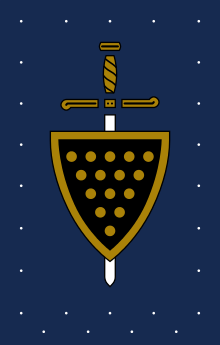203rd Infantry Brigade (United Kingdom)
203rd Infantry Brigade was a Home Defence formation of the British Army during World War II.
| 203rd Infantry Brigade | |
|---|---|
 Devon and Cornwall County Division insignia | |
| Active | 11 October 1940-1 September 1944 |
| Country | |
| Branch | |
| Type | Infantry Brigade |
| Role | Home Defence |
| Part of | Devon and Cornwall County Division 77th Division |
Origin
The brigade was formed as 203rd Independent Infantry Brigade (Home) for service in the United Kingdom on 11 October 1940 by No 3 Infantry Training Group in the South West Area (later Devon and Cornwall County Division) of Southern Command. It consisted of five recently formed infantry battalions.[1][2] Home brigades had a purely static defence role.[3]
Service
203rd Independent Infantry Brigade (Home) served in SW Area/Devon and Cornwall County Division until 1 December 1942, when the County Division was renamed 77th Infantry Division and the brigade was redesignated 203rd Infantry Brigade.[1][4][5] On 1 September 1944, 77th Division was disbanded and its personnel reformed as 45th (Holding) Division. At the same time 203rd Brigade was redesignated 134th Infantry Brigade (replacing a disbanded formation with the same number). All of these formations remained in the United Kingdom throughout the war.[1][6][7]
Order of Battle
203rd Brigade was composed as follows:[1]
As part of the Devon and Cornwall County Division:
- 11th Battalion, West Yorkshire Regiment (formed in July 1940 at York;[8] to 214 Bde 14 July 1941[9])
- 7th Battalion, East Yorkshire Regiment (formed in July 1940, at Beverley[10])
- 8th Battalion, Bedfordshire and Hertfordshire Regiment (formed in July 1940 at Bedford[11])
- 6th Battalion, Duke of Cornwall's Light Infantry (formed in May 1940 at Truro as 50th Holding Battalion, DCLI; became 6th Bn on 9 October 1940[12])
- 8th Battalion, Duke of Wellington's Regiment (formed in Summer 1940 at Otley; converted into 145th Regiment Royal Armoured Corps, on 1 November 1941[13][14])
Between 30 June and 19 July 1941 the 7th East Yorks, 6th DCLI and 8th Beds & Herts were all transferred to reconstitute 73rd Independent Bde, which took over all the static units in Cornwall.[15] This left 203rd Bde with only 9th Duke of Wellington's under command, but the following units were added to it over time:[1]
- 12th Battalion, Devonshire Regiment (from 226th Brigade 19 July 1941;[16] left 8 September 1942)
- 9th Battalion, Buffs (Royal East Kent Regiment) (from 209th Bde 16 August 1941; returned to 209th Bde 14 November 1941[17])
As part of 77th Division:
- 9th Battalion, Essex Regiment (from 226th Bde 23 November 1941;[16] to 219th Bde 17 September 1942[18])
- 10th Battalion, Loyal Regiment (North Lancashire) (from 210th Bde 25 November 1941;[19] on 28 May 1942 this battalion was used to reconstitute the Regular 2nd Bn (captured at the Fall of Hong Kong 25 December 1941);[20] 2nd Bn went to 199th Bde on 15 September 1942[21])
- 11th Battalion, Hampshire Regiment (from 214th Bde 10 September 1942;[9] to 209th Bde 23 September 1942[17])
- 2nd Battalion, East Surrey Regiment (from 219th Bde 15 September 1942;[18] to 134th Bde 3 January 1943[7])
- 10th Battalion, Royal Sussex Regiment (from 219th Bde 18 September 1942;[18] left 24 October 1943 and disbanded 4 December at Durham[22])
- 15th Battalion, Queen's Royal Regiment (West Surrey) (from 219th Bde 28 September 1942;[18] left 24 October 1943 and disbanded 4 December at Durham[23])
- 8th Battalion, Devonshire Regiment (from 134th Bde 4 January 1943;[7] to 211th Bde 2 November 1943[24])
- 11th Battalion, South Staffordshire Regiment (from 199 Bde 16 October 1943;[21] to 209 Bde 14 November 1943[17])
- 11th Battalion, York and Lancaster Regiment (from 213th Bde 17 November 1943;[25] to 143rd Bde 24 July 1944[26])
- 9th Battalion, Seaforth Highlanders (from 213th Bde 17 November 1943;[25] to 144 Bde 22 July 1944[27])
As part of 45th Division (renamed as 134th Infantry Brigade) to end of war:
- 7th Battalion, Royal Ulster Rifles (from 144th Bde 15 November 1943[27])
- 11th Battalion, Argyll and Sutherland Highlanders (from 45th Bde 23 July 1944[28])
- 2/6th Battalion, Lancashire Fusiliers ( from 220th Bde 25 July 1944[29])
- 14th Battalion, Durham Light Infantry (from 209th Bde 15 November 1944[17])
Commanders
The following officers commanded the brigade:[7]
- Brigadier G.E.M. Whittuck ( until 16 August 1941)
- Brigadier G.H. Gilmore (16 August 1941–1 August 1944)
- Brigadier J.H. Hogshaw (from 1 August 1944)
Notes
- Joslen, p. 366.
- Joslen, p. 108
- Joslen, p. 223.
- Collier, Map 20.
- Joslen, pp. 100, 108.
- Joslen, pp. 73, 100.
- Joslen, p. 320.
- Frederick, p. 180.
- Joslen, p. 377.
- Frederick, p. 182.
- Frederick, p. 231.
- Frederick, p. 138.
- Forty p. 50
- Frederick, pp. 12, 96.
- Joslen, p. 304.
- Joslen, p. 389.
- Joslen, p. 372.
- Joslen, p. 382.
- Joslen, p. 373.
- Frederick, pp. 190–2.
- Joslen, p. 363.
- Frederick, p. 212.
- Frederick, p. 200.
- Joslen, p. 374.
- Joslen, p. 376.
- Joslen, p. 328.
- Joslen, p. 329.
- Joslen, p. 290.
- Joslen, p. 383.
References
- Basil Collier, History of the Second World War, United Kingdom Military Series: The Defence of the United Kingdom, London: HM Stationery Office, 1957/Uckfield: Naval & Military, 2004 ISBN 978-1-84574-055-9.
- George Forty, British Army Handbook 1939–1945, Stroud: Sutton Publishing, 1998, ISBN 978-0-75245240-1.
- J.B.M. Frederick, Lineage Book of British Land Forces 1660–1978, Vol I, Wakefield: Microform Academic, 1984, ISBN 1-85117-007-3.
- J.B.M. Frederick, Lineage Book of British Land Forces 1660–1978, Vol II, Wakefield: Microform Academic, 1984, ISBN 1-85117-009-X.
- Lt-Col H.F. Joslen, Orders of Battle, United Kingdom and Colonial Formations and Units in the Second World War, 1939–1945, Volume I, London: HM Stationery Office, 1960/Uckfield: Naval & Military, 2003, ISBN 1-84342474-6.